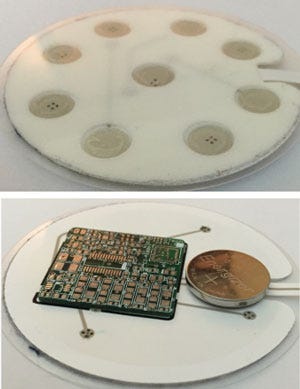A Wearable for the GI Tract
December 9, 2014
Before coming to medtech, Steve Axelrod, PhD, started out as an elementary particle physicist. Now, his interest is in developing technology to help people with gastrointestinal disorders, a problem affecting as many as 1 in 4 people. "I have a strong personal connection here," Axelrod explained at last week's BIOMEDevice San Jose. "In the summer of 2007, I spent five weeks sleeping on an air mattress in the hospital next to my 13-year-old daughter who had just been diagnosed with Crohn's disease. A few years later, my sister was diagnosed with colon cancer. And a few years later, my mother died from colon cancer."
|
A prototype of the GutCheck patch, which measures about 2.5-in. and has multiple electrodes. |
To help other patients suffering from GI problems, Axelrod is working to develop a wearable wireless system known as the GutCheck Patch that monitors the GI tract. Axelrod is the CEO of G-Tech (Mountain View, CA), which is developing what it terms an EKG for the gut. "Just as the EKG for the heart measures the signals given off by heart muscle as it contracts, and provides critical functional information about it, we are going to measure the electrical signals given off by the stomach, small intestine, and colon. We'll use that to understand the motor activity to diagnose the motility, which is at the heart of most functional disorders," Axelrod said.
Why is this necessary? Well, for one thing, the GI system is very complex. Lined with smooth muscle cells and containing hundreds of million neurons, the gut is linked to the brain in what is termed "the brain-gut axis." In such a complicated system, it is easy for problems to arise. While some problems can be detected visually, such as in the case of colonoscopies, other problems can be hard to diagnose. "Things can look fine but you can still have problems," Alexrod said.
The tools physicians have to monitor problems with the GI tract are largely anatomic: colonoscopies, endoscopies, and CT scans. "A doctor treating a patient with a GI tract problem can do these tests and find nothing is wrong. They come back and say: 'oh, you don't have cancer,'" Axelrod said. But still a functional problem can persist.
What is really needed is a better way of diagnosing functional problems. While there are some diagnostic tests available for the problems (even eating radioactive eggs and then imaging the gut with a gamma camera), these methods are limited.
Enter the GutCheck patch. A 2.5-in. smart Band-Aid equipped with Bluetooth LE and multiple pairs of electrodes, a patient would wear three of the devices, located at various positions, for a few days at a time. "The heartbeat is about a second. The gut beat is a day," Axelrod said. "So you need to test for at least a day to get some statistics."
The company had the idea of an iPhone-based Bluetooth LE approach in 2011, when it was met with skepticism. The approach, however, seems obvious now, Axelrod explained.
After the data is gathered from the device, it is processed in the cloud. "We have hundreds of millions of data points and we'll pull out some of the interesting bits that relate to motility." A report is then generated and made available as a download to the physician, who can then use the information to develop a directed therapy. In the end, it's much less stress to the patient, and much less cost to the healthcare system, Axelrod said.
Refresh your medical device industry knowledge at MD&M West, in Anaheim, CA, February 10-12, 2015. |
Brian Buntz is the editor-in-chief of MPMN and Qmed. Follow him on Twitter at @brian_buntz.
Like what you're reading? Subscribe to our daily e-newsletter.
About the Author(s)
You May Also Like


.png?width=300&auto=webp&quality=80&disable=upscale)
